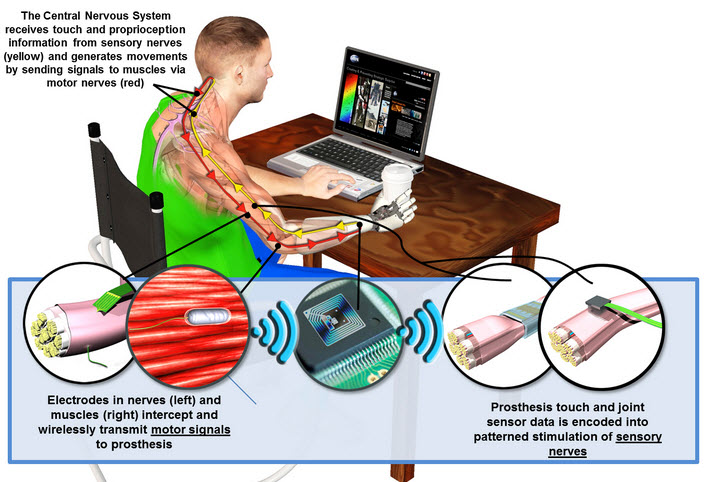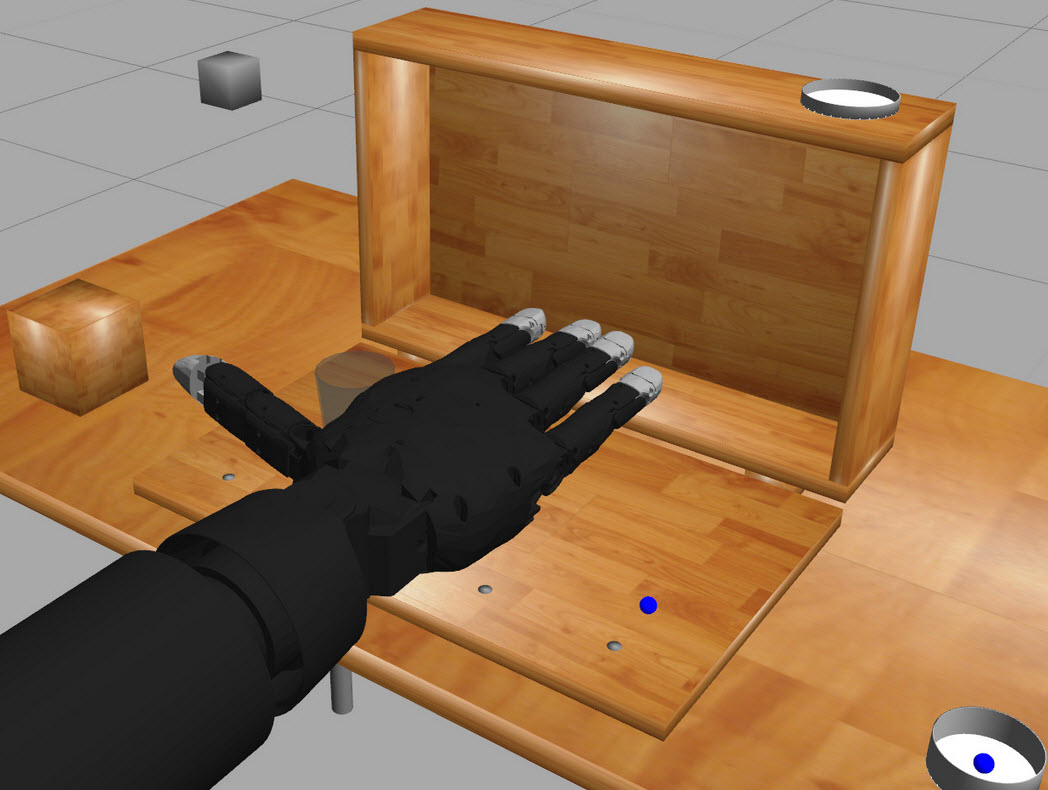A prosthetic hand that moves and provides sensation, just like a natural hand
February 13, 2015

DARPA’s Hand Proprioception and Touch Interfaces (HAPTIX) program aims to develop fully implantable, modular and reconfigurable neural-interface systems that would enable intuitive, dexterous control of advanced upper-limb prosthetic devices. In a major step toward achieving these goals, DARPA has awarded prime contracts for Phase 1 of HAPTIX. (credit: DARPA)
In another major step toward dissolving the boundaries between machine and human, the Defense Advanced Research Projects Agency (DARPA) has awarded prime contracts for Phase 1 of its Hand Proprioception and Touch Interfaces (HAPTIX) program to a multi-institution research team. HAPTIX (a play on “haptics“) seeks to create a prosthetic hand system that moves and provides sensation like a natural hand, according to DARPA.
Despite recent advances in technology for upper-limb prostheses, artificial arms and hands are still unable to provide users with sensory feedback, such as the “feel” of things being touched or awareness of limb position and movement.

To help HAPTIX performers more quickly and effectively conduct their research, DARPA is providing each team with open-source simulation software so they can test their designs. The software includes a variant of the DARPA Robotics Challenge Simulator from the June 2013 Virtual Robotics Challenge, the first stage of the DARPA Robotics Challenge. (credit: DARPA)
HAPTIX seeks to create “a sensory experience so rich and vibrant that users would want to wear their prostheses full time,” said DARPA’s statement. “By restoring sensory functions, HAPTIX also aims to reduce or eliminate phantom limb pain, which affects about 80 percent of amputees.” The ultimate goal: help restore full and natural functionality to wounded Service members and veterans.
Specifically, the idea is to incorporate sensors that provide tactile and proprioceptive feedback to the patient from their hands, delivered through a patterned stimulation of sensory pathways in peripheral nerves. So the bionic hand would be able to perform movements of a human hand and experience pressure, touch, and texture.
President Obama referred to DARPA’s numerous advanced prosthetics programs in his 2015 State of the Union address in January, saying the U.S. government is interested in “creating revolutionary prosthetics, so that a veteran who gave his arms for his country can play catch with his kids again.”
DARPA hopes to convince the FDA to fast-track approval for human trials of a complete, FDA-approved HAPTIX prosthesis system within four years.
DARPA is working with teams led by the following institutions:
- Lawrence Livermore National Labs (LLNL) Neural Tech Group
- Case Western Reserve University
- Cleveland Clinic
- Draper Laboratory
- Nerves Incorporated
- Ripple LLC
- University of Pittsburgh
- University of Utah
- University of Florida
Miniaturizing electronics
LLNL said it intends to further develop the advanced prosthetic limb systems developed under DARPA’s Revolutionizing Prosthetics and Reliable Neural-Interface Technology (RE-NET) programs, intended to provide a direct, powerful link between user intent and prosthesis control. Meaning: control prosthetic hand movements with their thoughts and have natural sensations.
LLNL is developing wireless electronic packages for HAPTIX called smart packages. These packages would contain electronics that record and stimulate the peripheral nervous system to control movement and sensation in a patient’s prosthetic hand.
LLNL plans to design smart packages to miniaturize electronics normally the size of a third of a cell phone into a package the size of a watch battery. The electronics would be made of ceramics and titanium, biocompatible materials that would seal the package tightly, preventing components from leaking into nerves or human tissue from entering the package.
The Neural Tech Group is also collaborating with Medtronic and Ardiem Medical. Some collaborators plan to develop the electrode arrays for sensation and muscle control, while others aim to validate and characterize it.
DARPA | HAPTIX Virtual Limb Simulator Technologies
DARPA | DARPA Prosthetics Reference in 2015 State of the Union Address
DARPA | Revolutionizing Prosthetics — Drinking from a Water Bottle